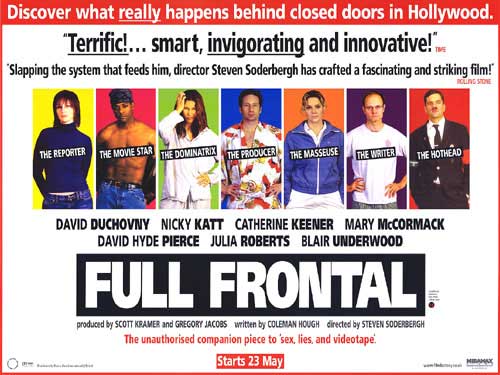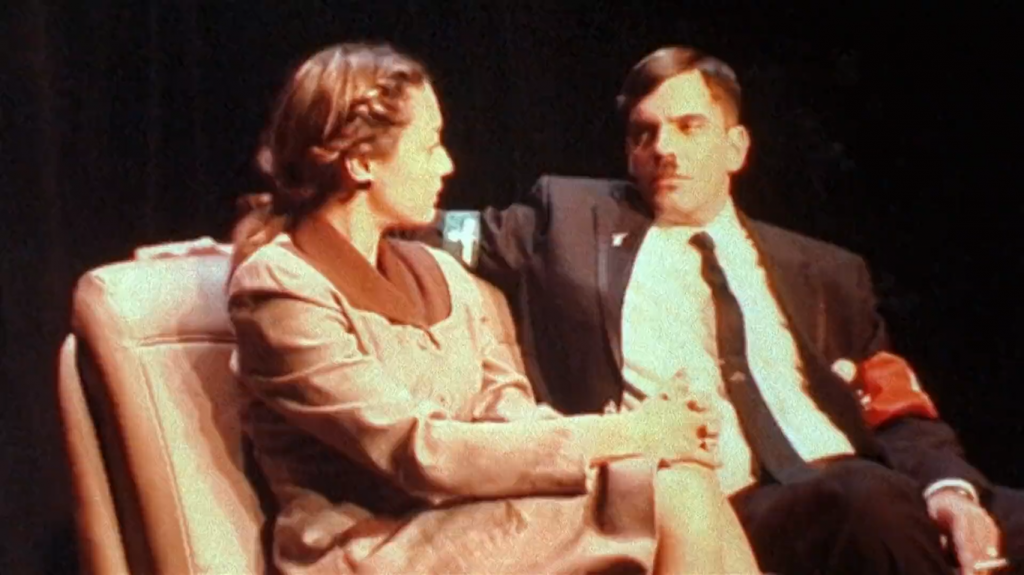For some people, watching a movie set in or around Hollywood is just too much inside baseball. But for the diehards, exploring the world of filmmaking has birthed some of the medium’s greatest triumphs. Over the next few months, our very own Dominic Griffin is going to revisit the gems of Movies on Movies…
Chameleon auteur Steven Soderbergh is no stranger to meta-fiction, but his 2002 film Full Frontal represents the apex of his fascination with concentric layers of reality. Shot in eighteen days and conceived as a burnt out blooming onion of artifice, the film follows a movie within a movie within yet another movie. The performers are all recognizable faces, so each were encouraged to drive themselves to set, pick their own wardrobe and handle their own hair and make-up to dull their sharp celebrity edges. The end result is an experimental look at Hollywood with a Godardian twist, amping up the inherent peculiarity of the movie business while flattening its idiosyncratic peaks into a surprisingly mundane slice of life anthology.
The surface-level film features a sprawling cast of Los Angelinos working in various aspects of the entertainment industry. Catherine Keener is Lee, a human resources rep at a movie studio. Her husband Carl (David Hyde Pierce) is a magazine writer who lucked up and sold a screenplay with his partner Arthur (Enrico Colantoni), a playwright and part-time actor struggling with an off-kilter production about Hitler. The film Carl and Arthur have penned, Rendezvous, stars Calvin (Blair Underwood) and Francesca (Julia Roberts). This film is also about the making of a film, one Calvin co-stars with Brad Pitt in, directed by David Fincher, who both appear as themselves. If that wasn’t enough, in one crucial scene, the fourth wall is shattered, showing Soderbergh himself (obscured by black bars on screen) directing Underwood and Roberts as Calvin and Francesca AS Catherine and Nicholas.
It’s a mind melting moment punctuated by Fincher in the background explaining to Pitt that, no, as far as his character knows, there’s only one movie. On paper, it sounds like a lot to keep track of, but on the screen it is strangely straightforward.
Part of this ease of understanding comes from Soderbergh’s chosen style here. Full Frontal is largely shot on crude digital video made to look and feel as shitty as Godard has any time he’s experimented with the medium. That inherent ugliness grounds this fiction into a hazy, pixelated simulacrum we more closely recognize as real life, or something like it. When we cut into the movie within a movie, those scenes are primarily shot on film. But Soderbergh isn’t really concerned so much with exploring the bridge between the real world and the artifice of Hollywood. Instead, he’s examining how, in real life, we’re each the star of our own narrative sphere and seldom can we comprehend how our arcs intersect with those around us.
Just as Brad Pitt is only aware of the one movie, Carl sees himself as the lead in a sullen dramedy about a struggling writer, unaware that his wife is cheating on him with Calvin, an actor he didn’t even want reading the words he’s conceived. Lee’s sister Linda (Mary McCormack) lives in her own romantic drama as a masseuse looking for love, until she is coerced into giving movie producer Gus (a brief, but wonderful turn from David Duchovny) a handjob in his hotel room that goes too far. Nicky Katt plays the lead actor in Arthur’s play (literally credited as Hitler) and the only world he’s willing to acknowledge is the terrifying little niche he’s created within Arthur’s production. (Katt steals the entire movie with his singular vision of thespian douchebaggery, at one point saying, of an actress who refuses to keep working with him, “Anyone who’s offended by drinking blood doesn’t really drink blood.”)
Really, it’s that incisive humor that keeps Full Frontal from being a navel gazing exercise in indulgence. Film lovers will catch no shortage of shade in passing one-liners or other accouterments filling out the frame. When Rendezvous opens, the comical swelling of the score is so exaggerated and pointed that by the time a cinematography credit for SVEN JURGENS pops up, you’re already cackling, not to mention a background gag on the cover of Los Angeles magazine that reads “BRAD PITT WANTS TO BOIL YOUR BUNNY.” There’s more than enough to chuckle at to tide you over between overlong interludes characterized by elliptical dialogue and improvisational dramaturgy.
But for its purposefully amateurish aesthetic, Soderbergh is toying with our notions of reality and our individual places within it. That he’s assembled a game cast to stretch themselves within a form so familiar as to be rote is a testament to his unique abilities to make fresh even the most well worn story skeletons through tireless invention.
Check back in the coming weeks for the next installment of Movies on Movies…




